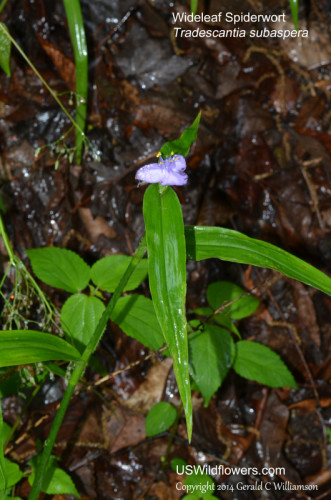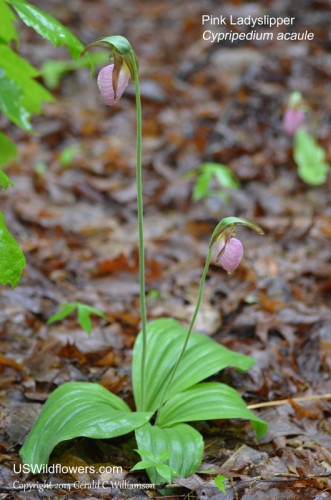Grassy Mountain is a 3600’+ peak in Murray County, Georgia, just outside the southwest corner of the Cohutta Wilderness. It’s probably best known as the home of Conasauga Lake, which at 3150′ is the highest lake in Georgia. It is formed by a small dam on the headwaters of Mill Creek. I’d spent a lot of time in and around the Cohutta Wilderness in the 90’s, but hadn’t been back much since then, so when I got an email last week from Mike Christison of the Georgia Botanical Society where he mentioned he’d seen Yellow Ladyslippers blooming on Grassy Mountain in the past, and that they were recently blooming at a much lower elevation, I figured this would be a great time for a return trip to the area. In spite of the cool temperatures, wind, and occasional rain, it WAS a great time; my wife and I identified (at least to a genus level) 37 40 different wildflower species in bloom, including this Wideleaf Spiderwort (Tradescantia subaspera.)
Our route was from US411 up Mill Creek Road to connect with USFS 64, out to the gate on Conasauga Lake Road, a walk about half way up to the tower, side trips to the boat launch and campgrounds on Conasauga Lake, back out to USFS 64, which we took past Little Bald and Bald Mountains, then down the Old CCC Camp Road to join Holly Creek and out to close the loop on US411 again. We made quite a few stops along the 10-mile Mill Creek Road, photographing these and many other wildflowers:
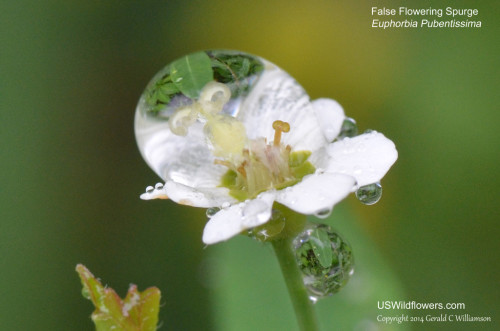
Closeup of raindrop on False Flowering Spurge – Euphorbia pubentissima. I didn’t realize this wasn’t Euphorbia corollata until I realized that doesn’t bloom until sometime in June.
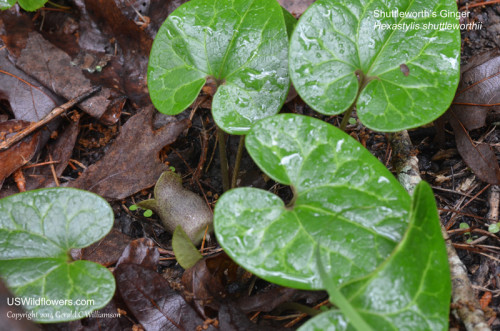
We were pretty excited to find Shuttleworth’s Ginger – Hexastylis shuttleworthii also along Mill Creek Road.
Making the turn onto USFS 64, we had 5 miles to go to Conasauga Lake. Rain started, but wildflowers continued.

This is only the 3rd place we’ve found American Lily of the Valley – Convallaria majuscula; the other two locations on Big Frog Mountain at the other end of the Cohutta Wilderness.
As we turned onto the Conasauga Lake Road, the roadside was covered with Wild Geranium – which, because it was raining, looked like pink-purple bells rather than the 5-petaled flowers we know on sunny days. We drove to the gate blocking the road up to the fire tower, and decided to walk on for a ways. A short distance up the trail we noticed another large patch of American Lily of the Valley, and looking beyond them, we noticed a patch of Pink Ladyslippers – among the largest we’ve ever seen.
Still no Yellow Ladyslippers, although since we were seeing so many other things we were not unhappy. We headed back down to the car and explored the roads down to the lake. One of them went to the very nice main campground. As we were headed back to the main road, I noticed a flower I had not seen before just off the road – White Clintonia.

White Clintonia – Clintonia umbellulata. You can see the spots on the blossom that give it another common name – Speckled Wood Lily
As we drove back out to USFS 64, the wind picked up and it started raining again, so I wasn’t inclined to stop again. However, my wife spotted a yellow flower as we drove by, so I backed up to the spot – it was this lovely Perfoliate Bellwort.

Perfoliate Bellwort – Uvularia perfoliata. This is what we stopped to see when Cindy spotted our primary target for the trip – below.
As I was photographing the Bellwort, Cindy said “What’s that yellow flower up there?” I looked, and recognized the foliage from the wildflower book I had with us – Yellow Ladyslipper! We had to climb a steep bank and tiptoe around the other flowers that were there – more Bellwort, and Catesby’s Trillium. The clouds covered the sun, and it was sprinkling rain. There was a pretty steady (cold!) wind – not ideal photo conditions, but we did manage to get a few acceptible shots of this single cluster of Cypripedium parviflorum, the original target of our quest.
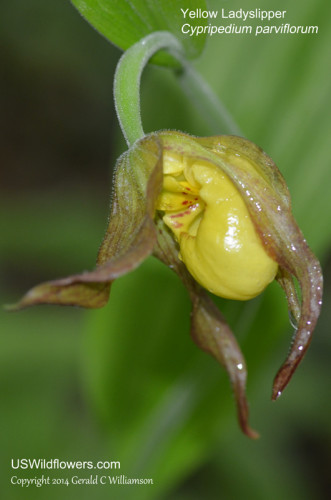
Yellow Ladyslipper – Cypripedium parviflorum. This is an odd angle, but the plants were somewhat beaten down by the wind and rain.
Satisfied, we headed out, but when I spotted a dark-ovaried Trillium, I had to stop. It could be the elusive Trillium simile. I photographed several plants in the colony, and some nearby Mayapples, and then we went on. I slapped my head – I hadn’t smelled the Trillium, a key method of identifying the three white-flowered, dark-ovaried Trilliums we have in the area. Trillium erectum var. album has a smell appropriate for one of the common names – Stinking Benjamin. The white form of Trillium sulcatum smells earthy, like a mushroom. Trillium simile has an aroma suitable for its common name, Sweet White Trillium. Of course, I remembered also that every time I stick my nose in a Trillium to smell it, I pay a price in allergic reaction, usually for at least a day. Just then I saw another dark-ovaried Trillium with wide overlapping petals. I decided to take one for the team, got out, and stuffed my nose down to the blossom. Reward! It smelled quite nice, nice and sweet – Sweet White Trillium!
It was a good and rewarding day, and included five “lifers” – I had not seen these in bloom before. Below is the list of flowers we saw and were able to identify at least to the genus level, compiled from photos we took and added to from my poor memory. * marks the lifers for me.
- Wideleaf (Zigzag) Spiderwort
- Rhododendron
- Solomon’s Seal
- Solomon’s Plume (False Solomon’s Seal)
- Penstemon (Beardtongue)
- Sweetshrub
- Smooth Phlox
- False Flowering Spurge *
- Thermopsis species
- Shuttleworth’s Ginger *
- Galax
- Wild Yam *
- White Milkweed (not fully open)
- Fourleaf Milkweed (open)
- Indian Pink
- Fleabane
- Bowman’s Root
- Foamflower
- Dogwood (I think, not Cornus florida)
- American Lily of the Valley
- Trillium (sessile or cuneatum)
- Catesby’s Trillium
- Trillium grandiflorum
- Trillium simile (confirmed sweet aroma)
- Wild Geranium
- Indian Cucumber Root
- Several Buttercups
- Pink Ladyslipper
- Yellow Ladyslipper *
- White Clintonia (Speckled Wood Lily) *
- Squawroot
- Perfoliate Bellwort
- Star Chickweed
- Blue Violet
- White Violet
- Mayapple
- Ragwort
- Yellow Stargrass
- Rue Anemone
- Wood Betony

